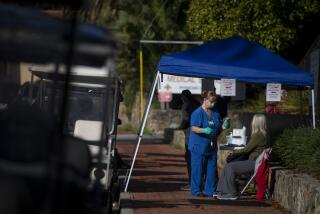Rural Hospital Appeals for Funds
- Share via
Cash-strapped Santa Paula Memorial Hospital is testing how deep the holiday spirit runs with an urgent plea for donations to keep the Santa Clara Valley’s only hospital afloat.
For the second year in a row, the Ventura County hospital has gone into the community, hand extended, seeking hundreds of thousands of dollars to keep its doors open for a few more months. Without $600,000 in donations, the facility -- a lifeline for thousands of residents in the farm belt from Santa Paula to Fillmore and Piru -- could be forced to drastically downsize or shut down.
The plea the hospital sent to supporters last Friday and spread through newspaper ads on Sunday, is grim. It warns that the 41-year-old hospital, built from community contributions, is “on the edge of a precipice” and could be “forced to permanently close its doors” unless it stems a cash-flow problem of “drastic proportions.”
It adds that any donations made to the nonprofit medical center before Dec. 31 are tax deductible on 2002 returns.
If the plight of the tiny 39-bed hospital sounds familiar, it is because Santa Paula Memorial has been experiencing hard times for a while.
The facility, operating at a loss since the 1980s, was forced to borrow money for the first time earlier this year. A decade of losses has drained $14 million from its reserves.
“This is real. This is not just a promotion to get people to donate money,” said rancher Anita Tate, a longtime member of the hospital board of directors. “There’s a limit to how long you can operate without making money.”
The problems at Santa Paula Memorial are indicative of a wider crisis in rural health care in California.
Twenty-six hospitals have closed in Southern California in the last seven years and nearly two-thirds of 440 hospitals in the state are losing money on operations, according to the Health Care Assn. of Southern California.
Santa Paula Memorial lost $325,000 last month alone, officials said. It costs $1.3 million a month to operate, and expenses are climbing by 2% per year.
The money pays for a maternity unit, surgery stations and a round-the-clock emergency room, the only one for miles around.
More to Read
Sign up for Essential California
The most important California stories and recommendations in your inbox every morning.
You may occasionally receive promotional content from the Los Angeles Times.










